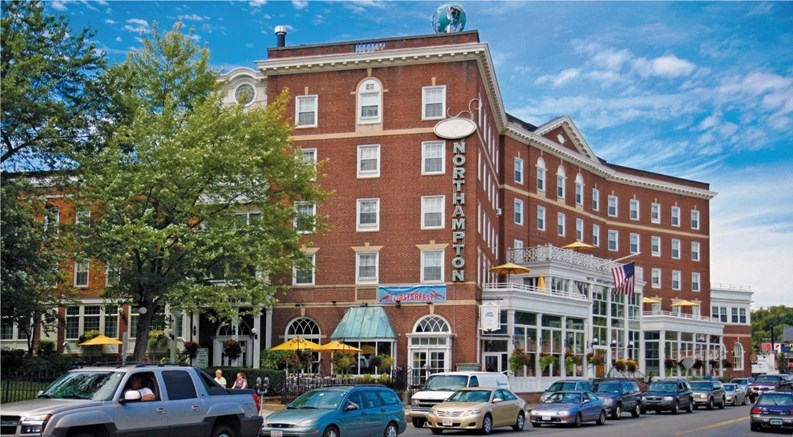What do Northampton, Massachusetts, and Brooklyn, New York, have in common? A fair share of transplanted Manhattanites. Restaurants featuring local ingredients. Great music. A strong gay and lesbian community. Families with young kids. And tattoos. Lots of tattoos.
Of course, there are differences. Brooklyn is a multi-ethnic, multi-racial borough of New York City and, with two and a half million residents, the fourth most populous city in America.
Northampton is a tiny former manufacturing enclave of 30,000 nestled along the banks of the Connecticut River in Western Massachusetts.
But don’t tell that to its residents. With the beautiful Holyoke range to the south and the Berkshires beckoning to the west, this small city enjoys the surrounding rural tranquility, but workshardest to showcase its urban spunk. “We are really known for our arts and crafts and our Main Street,” explains Suzanne Beck, executive director of the Greater Northampton Chamber of Commerce. “We are getting a lot of attention and it shows in the many ‘best of’ lists Northampton has been on recently.”
While the Connecticut River Valley has always been beautiful, Northampton has not always been progressive. CalledNonotuck when granted its charter over 350 years ago, its first settlers were Puritans and the original ethos of the area was, well, puritanical.
Despite the restrictive culture of the town, the land along the Connecticut River was incredibly fertile and farms flourished. Northampton did not prosper economically as much as it might have in its first century, however. This was largely due to land-based taxes and from being on the western side of the Connecticut River.
More than a hundred years after its original founding, two developments would help change Northampton’s prospects. One was a political protest and the other the construction of a bridge. (Ironically, modern residents will tell you that bridge construction and protests still affect logistics today.)
Tax Revolt
Northampton’s economic path was altered first by Shays’ Rebellion, a grass-roots revolt against the crushing taxes farmers faced after the Revolutionary War. Daniel Shays, a landowner from the nearby town of Pelham, led an uprising of mostly poor farmers in 1786 hoping to prevent government seizure of their property by physically closing courts in western Massachusetts, including the Hampshire County Courthouse.
The second vital change was the construction of bridges at the turn of the nineteenth century. These bridges opened up access to Eastern Massa-chusetts and allowed Northampton to maximize the benefit of its location between Boston, New York and Albany. With the improved access to roads and the addition of railroads, industry took off and brick factories – many carefully restored today – sprang up to produce buttons, textiles, caskets, small machinery and silk.
Polish, Canadian and Irish immigrants flocked to Northampton to work and subsequently established the town’s working-class base. In 1883,Northampton was incorporated as a city, but to this day it still feels more like a bustling small town than a metropolis.
There is still a proud blue-collar aspect to the community, and tradesmen and workers live side by side withacademics, professionals and artists. This mix is often cited as one of the most appealing aspects of modern Northampton. It also distinguishes the city from its neighbor, Amherst.
Prestigious Colleges
Separated by a few miles and a river, Northampton and Amherst are often described in relation and in contrast to one another. Both are small municipalities with strong historical ties to a prestigious liberal arts college (Smith in Northampton and Amherst College in Amherst) as well as current ties to the other colleges in the “Five College System,” Hampshire College, the University of Massachusetts, and MountHolyoke College.
But while Northampton added manufacturing in the nineteenth century, Amherst remained predominantly academic and agrarian. Althoughlocals frequently debate the merits of living in Amherst versus living in Northampton, in reality, residents of both towns are likely to make a daily trip “across the river” to work, play or shop.
Due to the success of its early industries, Northampton enjoyed an era of prosperity at the end of the nineteenth century and the early twentieth century that allowed it to become a center of philanthropy, art and education. The 19th century opera singer Jenny Lind, known as the “Swedish Nightingale,” loved the place so much she performed here, honeymooned here, and gave the town its nickname, “Paradise City.”
Locals proudly hold onto the moniker, though few know anything of the singer who originally coined it. Residents are far more likely to boast of modern musicians who started in Northampton’s numerous music venues, including, among many others, Fountains of Wayne, the Winterpills, Sonic Youth, Erin McKeown and the Primate Fiasco.
Smith College Founded
Oliver Smith kicked off North-ampton’s culture of education and philanthropy in 1845 when he foundedThe Smith Vocational School. While the Vocational School planted North-ampton’s egalitarian roots, the Smith family’s most famous contribution to the town came from Oliver’s niece, Sophia.
Sophia Smith used her fortune in 1871 to found Smith College, widely considered the best women’s college in the country. Begun with a handful of students, today over 2,600 women from 48 states and 72 countries come to Smith to study.
“Smith College and Cooley Dickinson Hospital, both non-profit organizations, are the largest employers in town,” Beck notes, “while Kollmorgen Electro-Optical is the largest for-profit employer, with 400 employees.” Kollmorgen was enticed to Northampton in the fifties, she explains, and has been a steady producer of periscopes and other optical equipment since that time.
Beck adds “there are also small clusters of other industries in town, including a few producers of very technical temperature measurement instruments and several companies that make high-end furniture and cabinetry.”
While some of these are located in Northampton’s Industrial Park, one notable pioneer, Volz Clarke & Associates, Inc., a custom furniture andarchitectural millwork manufacturer, was the first full-time commercial tenant at Village Hill, at the former state mental hospital.
Newcomers Provide Revitalization
It was the closing of the huge state hospital in the 1970s that began Northampton’s revitalization after decades of economic decline, the result of the 20th century loss of manufacturing across New England. The phasing out of the huge psychiatric hospital, which had capacity for more than 2,000 patients and was originallybuilt in 1856, brought mental health workers, therapists and other professionals to the area to supply services no longer provided by the residential institution.
The newcomers provided funds and fresh enthusiasm to restore the ailing downtown. Thornes Market was one of the first and most appealing projects of the downtown revitalization. Opened in 1979, Thornes transformed a former department store on Main Street into a collection of funky stores and restaurantsunder one roof. The market today has more than 25 shops, restaurants and galleries and continues to draw locals and visitors alike.
Also during this period, a cohesive gay and lesbian community was establishedin the area, which in turn attracted progressive and counterculture types of all sexual persuasions.
Northampton experienced a major cultural shift with the arrival of writers, artists, activists and musicians. While often causing culture shock and consternation for residents whose families had lived in the area for generations, the reemergence of Northampton as assertively liberal has proved an economic boon.
Today healthcare, education, retail and entertainment provide more than two-thirds of the jobs in town, and while there is still some manufacturing, most of it is artisanal.
“Cool” Factor
Northampton’s popularity and increased “cool” factor can be seen in the appreciation of real estate values. According to the Assessor’s Office, the average price for a single family home in 2010 was $302,200 and the average condominium price was $182,700. Joan Sarafin, principal assessor for City of Northampton, notes that for a city this size, “condominiums have become very popular. Northampton’s housing stock includes just over 5,000single-family homes and nearly 1,500 condominiums.” Even more unusual, Beck adds, “almost 50% of the town’s housing units are rentals, a rate that is higher than Boston’s.”
Pioneer Valley realtor Nancy Hamel, who with her daughter is the “Hamel Team” of The Jones Group, explains the growing appeal of condominiums: “People are attracted to the idea of city living; to living in the middle of town. People choose Northampton for this urban feeling.” Many other condo buyers, Hamel adds, are “retirees who welcome the freedom of turning a key and leaving for several months without worrying.” Retirees and graduate students, hipsters and the ecologically-minded, condominium buyers come in many shapes in Northampton – as do the condominiums.
Northampton has condominiums available in the $60-$70,000 range, frequently purchased by graduate students at Smith and UMass, as well as high-end properties selling in the $500- $700,000 range. “The condominiums at Bear Park,” Sarafin gives as an example, “are relatively new and are mostly free-standing homes built on a hill just outside of town. They are lovely.”
Northampton’s diverse condo inventory also includes “Laurel Park,” originally built as cabins in 1870 for religious retreats, now a community of year-round and seasonal homes, and the “Old School Commons,” three adjacent schools converted to retail and residential condominiums about ten years ago.
From a fire and brimstone beginning to its progressive present, Northampton has recreated itself many times in its 350-year existence. The ebbs and flows of politics, commerce, education and art have led to the present community –a truly interesting mix of people, lifestyles and tastes. Although not without problems, this blend makes for a very unusual and very appealing place to live.
Sarah Sanford is a freelance writer and a frequent contributor to New England Condominium magazine.







Leave a Comment